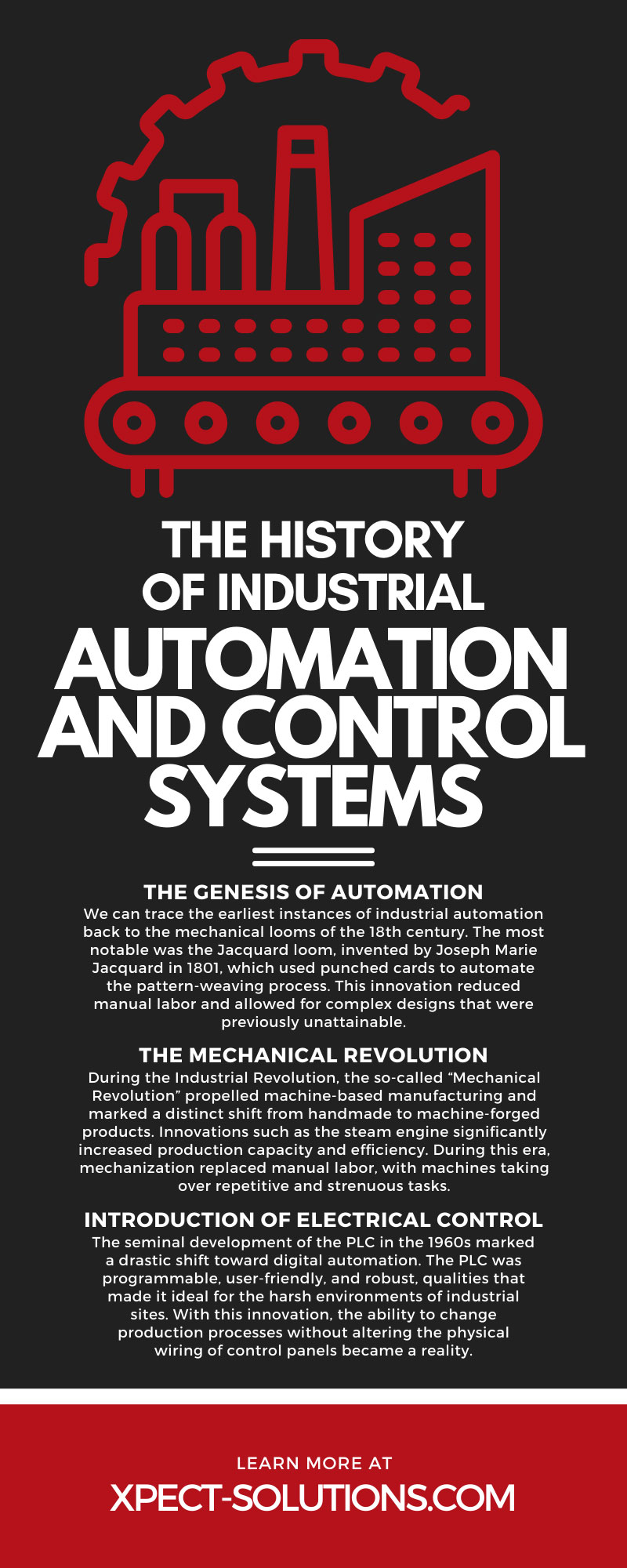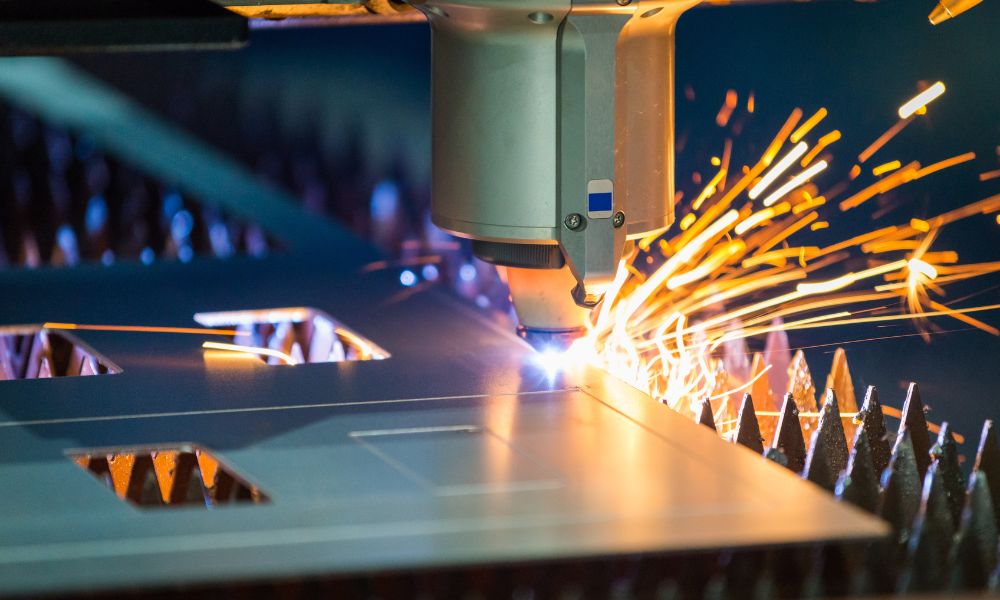Industrial automation and control systems have revolutionized manufacturing goods and managing processes. From rudimentary mechanical contraptions to the interconnected systems that choreograph modern production lines, the evolution of these systems is a testament to human ingenuity and the relentless pursuit of efficiency.
Let’s look at the history of industrial automation and control systems and how they have shaped our world.
The Genesis of Automation
We can trace the earliest instances of industrial automation back to the mechanical looms of the 18th century. The most notable was the Jacquard loom, invented by Joseph Marie Jacquard in 1801, which used punched cards to automate the pattern-weaving process. This innovation reduced manual labor and allowed for complex designs that were previously unattainable. Engineers continued to seek ways to increase productivity and reliability as the Industrial Revolution progressed.
The introduction of electrical engineering in the 19th century brought forth the development of the first electric motors, leading to increasingly autonomous machinery. The early 20th century witnessed a significant milestone with the assembly line, popularized by Henry Ford, which standardized the mass production process. Each step laid the groundwork for the sophisticated systems of today, where advanced computer algorithms and robotics often exercise control, integral to industries worldwide.
The Mechanical Revolution
During the Industrial Revolution, the so-called “Mechanical Revolution” propelled machine-based manufacturing and marked a distinct shift from handmade to machine-forged products. Innovations such as the steam engine significantly increased production capacity and efficiency. During this era, mechanization replaced manual labor, with machines taking over repetitive and strenuous tasks. This transition laid the foundation for modern industrial automation by illustrating the benefits of mechanical assistance in production processes.
With the increasing complexities of mechanical systems, engineers started embedding basic control mechanisms to ensure precision and safety. These ranged from simple governors on steam engines to regulate speed to more elaborate systems designed to synchronize the movements of different machine parts. This era embodied a significant leap in how humans leveraged machinery to perform labor, setting the stage for the following electronic and digital automation systems.
Introduction of Electrical Control
As the 20th century dawned, the next transformative phase in industrial automation emerged with the advent of electrical control systems. The introduction of relay logic control, utilizing electromagnetic relays, allowed for more complex and responsive manufacturing processes. A breakthrough enabled factory machinery to perform more intricate and sequential operations automatically. The forerunner of the modern Programmable Logic Controller (PLC) was the relay-based control system, which provided a flexible and reconfigurable solution to industrial control challenges.
The seminal development of the PLC in the 1960s marked a drastic shift toward digital automation. The PLC was programmable, user-friendly, and robust, qualities that made it ideal for the harsh environments of industrial sites. With this innovation, the ability to change production processes without altering the physical wiring of control panels became a reality. This shift exponentially increased the speed and ease with which production systems could adapt to new tasks and products.
The Advent of Programmable Logic Controllers (PLCs)
The introduction of Programmable Logic Controllers (PLCs) brought about unparalleled flexibility and control in automation. Businesses could program PLCs to perform various tasks and easily reprogram them for new processes, drastically reducing downtime and increasing the adaptability of manufacturing systems. Their reliability and durability under industrial conditions made them a mainstay in factories worldwide. The rise of PLCs paved the way for integrating computer technology into industrial processes, setting the stage for further advancements in automated control systems.
PLCs helped fine-tune assembly, packing, material handling, and robotic operations, resulting in dramatic improvements in efficiency and productivity. The PLC’s integration with software interfaces has also enabled real-time monitoring and data analysis, leading to smarter decision-making and predictive maintenance capabilities that continue pushing the boundaries of industrial automation.
Computer Numerical Control (CNC) Emergence
Following the widespread adoption of PLCs, the emergence of Computer Numerical Control (CNC) systems marked another revolutionizing stride in the automation sector. CNC technology transformed the face of manufacturing by allowing for the precise control of machinery such as lathes, mills, and grinders through computer programming. The level of precision available through CNC machining meant that businesses could create complex parts with exacting tolerance and repeatability.
CNC machines use digital instructions derived from Computer-Aided Design (CAD) files to orchestrate the movements of machinery with a level of accuracy unachievable by human operators. This technology also greatly enhanced production speed and reduced waste by optimizing cutting paths. The convergence of computing power with mechanical systems through CNC has propelled industries into an era of manufacturing characterized by high precision, minimal error, and the capacity for intricate designs.
The Dawn of Robotics in Manufacturing
The term “robotics” encapsulates the zenith of industrial automation. Its inception into manufacturing has revolutionized production floors by introducing robots capable of executing tasks with precision and consistency that human labor cannot match. The limitations of human endurance do not constrain these mechanical marvels; they can operate continuously, performing tedious, dangerous, and intricate jobs.
Businesses typically integrate robots into manufacturing through robotic arms, which have sensors and end-effectors that can weld, assemble, handle materials, and paint with unerring accuracy. Their deployment has led to a surge in productivity and safety while minimizing labor costs and human error. Moreover, the adaptability of robots in response to different tasks underscores a transformative shift toward flexible automation. The sway of robotics in manufacturing fortifies the promise for an even more automated and innovative industrial future.
The evolution of industrial automation marks a journey from mechanical ingenuity to sophisticated digital control. Each progression—from manual mechanization to the integration of PLCs, CNC systems, and robotics—has significantly enhanced manufacturing processes’ efficiency, safety, and versatility. The relentless pursuit of innovation within this field points to a future where automation optimizes production and fosters the creation of new industries and opportunities. As we look toward this horizon, it is clear that the role of automation will continue to be pivotal in driving industrial growth and economic prosperity.
If you need a control panel manufacturer, Xpect Solutions can provide custom control panels for your industrial automation needs. Contact us to find out more about our wide range of services and solutions.


